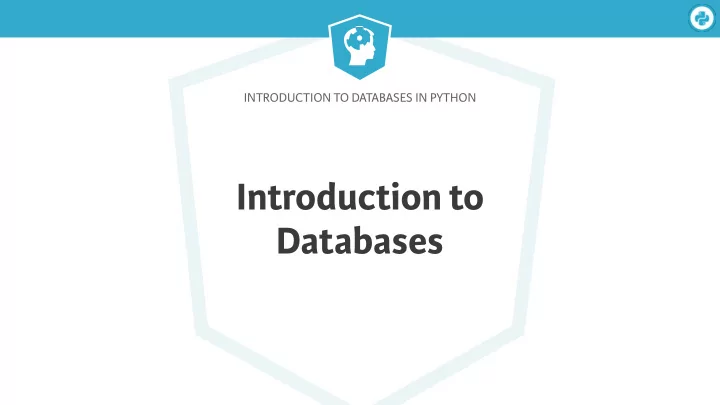

INTRODUCTION TO DATABASES IN PYTHON Introduction to Databases
Introduction to Databases in Python A database consists of tables Census State_Fact state sex age pop2000 pop2008 name abbreviation type New F 0 120355 122194 New York NY state York New F 1 118219 119661 Washington DC DC capitol York New F 2 119577 116413 Washington WA state York
Introduction to Databases in Python Table consist of columns and rows Census state sex age pop2000 pop2008 New F 0 120355 122194 York New F 1 118219 119661 York New F 2 119577 116413 York
Introduction to Databases in Python Tables can be related Census State_Fact state sex age pop2000 pop2008 name abbreviation type New F 0 120355 122194 New York NY state York New F 1 118219 119661 Washington DC DC capitol York New F 2 119577 116413 Washington WA state York
INTRODUCTION TO DATABASES IN PYTHON Let’s practice!
INTRODUCTION TO DATABASES IN PYTHON Connecting to a Database
Introduction to Databases in Python Meet SQLAlchemy ● Two Main Pieces ● Core (Relational Model focused) ● ORM (User Data Model focused)
Introduction to Databases in Python There are many types of databases ● SQLite ● PostgreSQL ● MySQL ● MS SQL ● Oracle ● Many more
Introduction to Databases in Python Connecting to a database In [1]: from sqlalchemy import create_engine In [2]: engine = create_engine('sqlite:///census_nyc.sqlite') In [3]: connection = engine.connect() ● Engine: common interface to the database from SQLAlchemy ● Connection string: All the details required to find the database (and login, if necessary)
Introduction to Databases in Python A word on connection strings ● 'sqlite:///census_nyc.sqlite' Filename Driver+Dialect
Introduction to Databases in Python What’s in your database? ● Before querying your database, you’ll want to know what is in it: what the tables are, for example: In [1]: from sqlalchemy import create_engine In [2]: engine = create_engine('sqlite:///census_nyc.sqlite') In [3]: print(engine.table_names()) Out[3]: ['census', 'state_fact']
Introduction to Databases in Python Reflection ● Reflection reads database and builds SQLAlchemy Table objects In [1]: from sqlalchemy import MetaData, Table In [2]: metadata = MetaData() In [3]: census = Table('census', metadata, autoload=True, autoload_with=engine) In [4]: print(repr(census)) Out[4]: Table('census', MetaData(bind=None), Column('state', VARCHAR(length=30), table=<census>), Column('sex', VARCHAR(length=1), table=<census>), Column('age', INTEGER(), table=<census>), Column('pop2000', INTEGER(), table=<census>), Column('pop2008', INTEGER(), table=<census>), schema=None)
INTRODUCTION TO DATABASES IN PYTHON Let’s practice!
INTRODUCTION TO DATABASES IN PYTHON Introduction to SQL Queries
Introduction to Databases in Python SQL Statements ● Select, Insert, Update & Delete data ● Create & Alter data
Introduction to Databases in Python Basic SQL querying ● SELECT column_name FROM table_name ● SELECT pop2008 FROM People ● SELECT * FROM People
Introduction to Databases in Python Basic SQL querying In [1]: from sqlalchemy import create_engine In [2]: engine = create_engine('sqlite:///census_nyc.sqlite') In [3]: connection = engine.connect() In [4]: stmt = 'SELECT * FROM people' In [5]: result_proxy = connection.execute(stmt) In [6] results = result_proxy.fetchall()
Introduction to Databases in Python ResultProxy vs ResultSet In [5]: result_proxy = connection.execute(stmt) In [6]: results = result_proxy.fetchall() ● ResultProxy ● ResultSet
Introduction to Databases in Python Handling ResultSets In [1]: first_row = results[0] In [2]: print(first_row) Out[2]: ('Illinois', 'M', 0, 89600, 95012) In [4]: print(first_row.keys()) Out[4]: ['state', 'sex', 'age', 'pop2000', 'pop2008'] In [6]: print(first_row.state) Out[6]: 'Illinois'
Introduction to Databases in Python SQLAlchemy to Build Queries ● Provides a Pythonic way to build SQL statements ● Hides di ff erences between backend database types
Introduction to Databases in Python SQLAlchemy querying In [4]: from sqlalchemy import Table, MetaData In [5]: metadata = MetaData() In [6]: census = Table('census', metadata, autoload=True, autoload_with=engine) In [7]: stmt = select([census]) In [8]: results = connection.execute(stmt).fetchall()
Introduction to Databases in Python SQLAlchemy Select Statement ● Requires a list of one or more Tables or Columns ● Using a table will select all the columns in it In [9]: stmt = select([census]) In [10]: print(stmt) Out[10]: 'SELECT * from CENSUS'
INTRODUCTION TO DATABASES IN PYTHON Let’s practice!
INTRODUCTION TO DATABASES IN PYTHON Congratulations!
Introduction to Databases in Python You already ● Know about the relational model ● Can make basic SQL queries
Introduction to Databases in Python Coming up next… ● Beef up your SQL querying skills ● Learn how to extract all types of useful information from your databases using SQLAlchemy ● Learn how to create and write to relational databases ● Deep dive into the US census dataset!
INTRODUCTION TO DATABASES IN PYTHON See you in the next chapter!
Recommend
More recommend